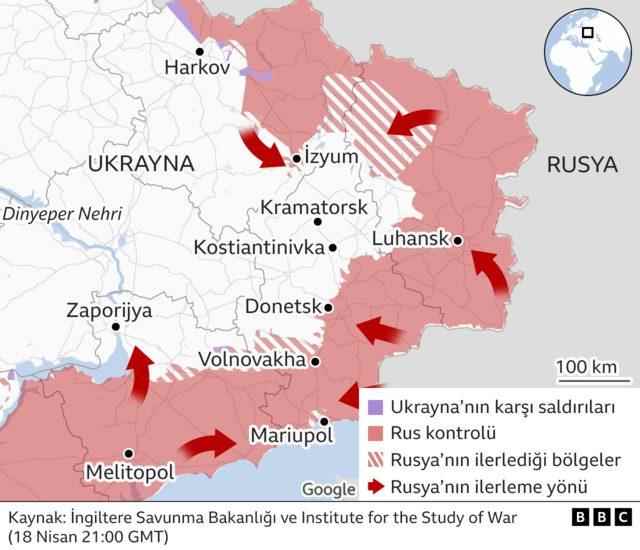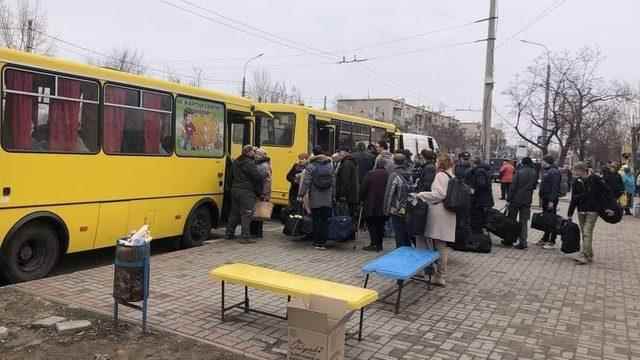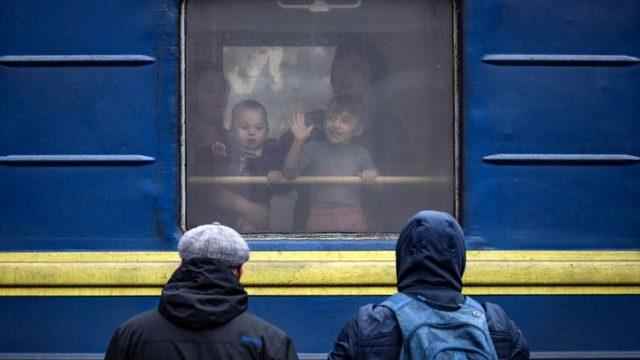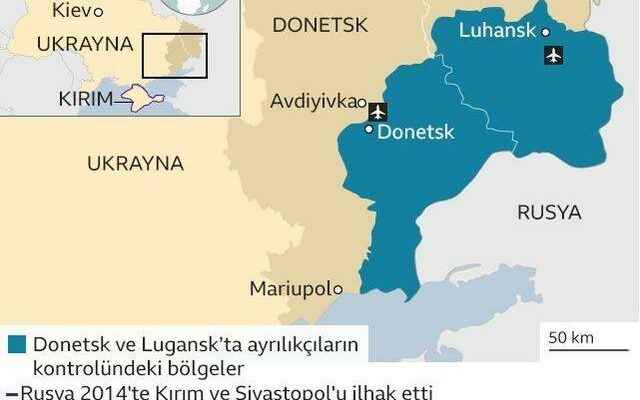After Russia withdrew its forces from the Ukrainian capital of Kiev, the war intensified in the east of the country. Ukrainian President Volodymyr Zelenskiy announced on Monday evening that a large-scale offensive had begun in Donbas and said that a significant part of the Russian army is fighting in the region.
What does Russian President Vladimir Putin have to do to proclaim victory in this former industrial zone he claims he will “liberate”? Is such a victory possible?
The best-trained forces of the Ukrainian army were already deployed in the east, due to the eight-year intermittent war that began in 2014 against pro-Russian separatists. It is known that they have suffered great losses during this time, but they are still making a very strong defense against the invading army of Russia.
There is a humanitarian crisis in the areas under Russian siege, especially in Mariupol. Despite this situation for weeks, Russia still could not take Mariupol. “We will fight for every inch of our land,” said Ukrainian President Zelensky.
What is the significance of Donbas?
When Russian President Vladimir Putin says “Donbas”, he means Ukraine’s former coal deposits and iron production centre. Actually, the place he’s talking about is the two big regions in the east; Luhansk and Donetsk, that is, almost the entire eastern part of the country from Mariupol to the far north.
“The key point here is that the Kremlin sees this area as the Russian-speaking part of Ukraine, more as Russia than Ukraine,” says Sam Cranny-Evans of the Royal United Services Institute.
However, although mostly Russian is spoken in these regions, most of them are no longer pro-Russian.
“Mariupol was the most pro-Russian region in Ukraine,” says defense expert Konrad Muzyka, head of Rochan Consulting.
One month after the start of the war, that is, at the end of March, Russia had 93 percent of Luhansk; He claimed that he had taken control of 54 percent of Donetsk. However, it is clear that there is still a lot of time before Putin takes over the entire region, that is, declares his victory. Even if Putin declares victory, this is a very large area to control.
Why does Putin want to control Donbas?
Putin has long been voicing allegations that Ukraine committed genocide in the east of the country, although he could never show evidence.
When the war began on February 24, two-thirds of the eastern territories were under Ukrainian control. The rest have been declared unilaterally by pro-Russians since the 2014 war; It existed as small autonomous regions backed by Russia.
A few days before the start of the war, Putin announced that these two regions had all accepted independence from Ukraine.
If Russia completely seizes both of these regions, it would give Putin a great opportunity to “succeed”. The next step would be to annex Donbas. Just like he did in Crimea in 2014 with a controversial and internationally unacceptable referendum…
If such a declaration of victory comes before May 9, Putin will not hesitate to celebrate Victory Day. This date is commemorated with great celebrations every year as the anniversary of the day Russia defeated Nazi Germany in 1945.
The leader of the Luhansk region, which is Russia’s “puppet”, has already started talking about a “future referendum”. Of course, it seems rather strange to talk about a referendum or any vote in a region where war is still going on right now.
What is Putin’s strategy?
The Ukrainian army said that Putin did not just want the domination of Donbas; He thinks Harson is targeting the entire region, from the south to the north and west of the Crimea. Because in this way, he will have controlled the entire region from the southern coast to the Russian border and the water supply line to Crimea.
Most of Donetsk and critical areas of Luhansk are still under Ukrainian control; For this reason, Russian forces are trying to besiege the powerful Ukrainian troops in the east by approaching from the north, south and east.
“This is a huge area to control, and we shouldn’t ignore its geographic challenges,” says Tracey German, an academy who teaches conflict and security at King’s College London.
They have yet to take control of Kharkov, Ukraine’s second largest city, just south of the Russian border, but they have managed to enter the critical town of Izyum, on the highway that provides access to the separatist-controlled eastern areas.
prof. German explains the importance of Izyum by saying, “If you look at what they did in Izyum, they continue on the main roads. This is very logical because they transport most of their vehicles and ammunition by road and rail.”

Currently, all the settlements targeted by Russia have been at war since 2014 when pro-Russians took over large areas of Donbas. The next destination on the M03 highway is the city of Slovyansk, where 125 thousand people live. This city, too, was besieged by pro-Russian separatists in 2014 and then recaptured by Ukrainian forces. After Slovyansk, Kramatorsk is just south of it.
According to the US-based Institute for the Study of War (ISW), if Ukraine manages to stand up to Russian forces in Slovyansk, Russia’s plan to seize all of the two regions will “probably fail.”
As the Russian army advanced from the north to the east, it has already attacked several towns in Luhansk, including Ukrainian-controlled Kremenna, Rubizhne, Popasna and Lysychansk.
According to the ISW, these towns are important because if Russia takes control of them, Russia can advance with its military vehicles westward and join forces that increase their offensive from Izyum to the southeast. For this reason, the Ukrainian army focuses on counter-attacks outside of Izyum.

The Russians now have to close the supply lines on the highways and block the railways coming from the west. The most effective troop and ammunition reinforcement method for the Ukrainian army is railways; This road is also the fastest way to evacuate civilians.
Controlling the railways also means easier transportation of soldiers and ammunition for the Russians.
There is also the possibility that the railways will be damaged during these counterattacks. Ukraine therefore hastened the evacuation of civilians.
The railways from Izyum to the north and to Mariupo and Melitopol in the south were cut off. There are also delays in train journeys in Slovyansk. In Kramatorsk, no trains have run since the train station attack, which killed 57 people while waiting for civilians to evacuate.

Can the Ukrainian forces hold out?
At the beginning of the war, the southern 10 brigades forming Operation Joint Forces were seen as the best-trained and best-equipped forces of the Ukrainian army.
“We really don’t know the actual strength of the Ukrainian forces at the moment,” says Sam Cranny-Evans, but over the past few weeks a large number of volunteers have been enlisted; He says that for this reason, they may become even stronger.
Russian forces have also suffered serious losses in the last seven weeks. Their morale is also estimated to be low. They continue to fight with the participation of the separatists inside Ukraine as well as the large Russian army.
“The main aim of the Ukrainians is to inflict as much damage as possible on the Russian side. They also use asymmetric tactics to prevent major wars,” says Konrad Muzyka.
